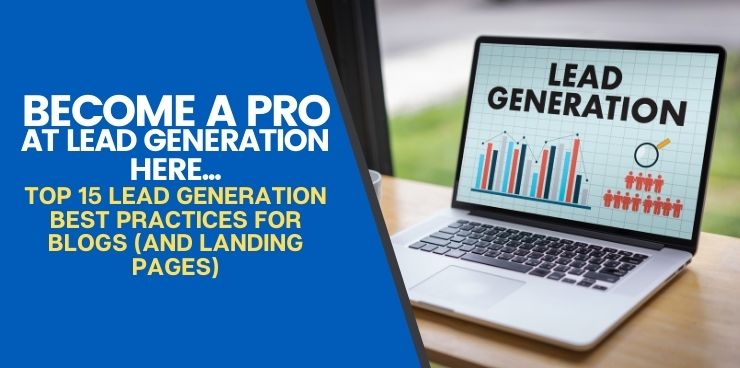Whether you know it or not, everyone is in multiple stages of the customer journey, right now– if you use the internet, that is.
Every day you are online, looking through your phone and either consciously or subconsciously absorbing the marketing that is presented to you.
Maybe you saw a blog post about the best burger shop in town and suddenly you’re hit with relentless hunger pangs, or maybe you’ve gotten an email about a yoga retreat from your favorite yoga studio.
No matter where you are in your customer journey, it’s important to remember: with just one click, a lead is born.
So how are you, as a business leader, going to make sure you are birthing as many high-quality leads as possible?
Well, that’s where we at Selling Revolution come in. We’ve provided the top 15 lead generation best practices for blogs and landing pages so you and your business have what it takes to be a lead generation expert.
Blog Post
Blog posts are where potential leads most commonly end up when searching for the information and answers they need.
This is why it is critical that your blog posts are following the lead generation best practices to stand out from your competitors and draw them in to click on your page.
1. Make Sure to Provide Audience with the Best Information and Answers
A potential lead is more likely to continue down your sales funnel when you provide them with all the useful information they are looking for in that first post.
And better yet, giving them an easy way to immediately engage with your product or services i.e. a sign-up form, social icons, share buttons or internal links to shared content will increase the likelihood of becoming a lead even more.
Having a high-performing blog template is essential for lead generation companies to excel in obtaining more leads and maximizing their B2B digital marketing.
 2. Start with Keyword-focused Header
2. Start with Keyword-focused Header
If you’ve got a commonly searched topic and your company has ample jurisdiction to compete for the phrase, then SEO is your way to go!
To beat your competitors in getting to the top of that search list, you will need a clean and impactful blog that is relevant to the keyword or phrase.
Most importantly, make sure that you use the primary keyphrase once in the <h1> header and once as well in the <title> tag.
3. Choose Topic Related Featured Image
Nothing online attracts the eyes better than an image.
Having an image attached to your blog post will make it more enticing and shareable– especially if your image stirs up some excitement or is thought-provoking.
Just be sure it is still related in some way to the contents of your blog so it isn’t misleading to your readers.
At Selling Revolution, we’ve helped a variety of businesses adopt the most effective lead generation tactics to ensure their revenue soars.
4. Always Include Social Sharing Buttons
Your potential lead won’t be able to give your blog post the exposure you aim for when it doesn’t have any social sharing buttons!
These sharing buttons don’t just have to go in one place, either. You can place them in multiple areas of your page as this will increase the likelihood your potential lead will see it and click.
According to Orbit Media Studios, 36 percent of blogs are above the article, 33 percent are next to the article and 35 percent are below the article. Talk about equal distribution!
5. Add Author’s Image
Another lead generation best practice is to add the author’s image to your article. This will make your marketing feel more personable and human.
Add a byline at the bottom of the article. Your reader will feel more connected to your brand and as a bonus, it’ll help your writer with potential networking opportunities.
To give it an even more personal touch, complement your byline with the author’s professional headshot.
6. Subheaders
Long, blocky text is a thing of the past. To enhance the readability of your blog posts, break up your paragraphs into subheaders.
Most readers scan the articles they read, so subheaders are a great way for them to find more specific information quickly.
7. Use Numbered and Bulleted Lists
Lists are another great way for scanners to easily digest the information they are searching for.
It not only provides easy readability but also allows you to use numbers in your article, which gives it the advantage to stand out more amongst the crowd of competitors.
8. Level-up with Graphics and Images
We’ve gone over how the featured image and author’s image play a role in lead generation, but what about incorporating other graphics and images into your blog post?
Adding a visual element to your article is a lead generation best practice because it breaks up a wall of text and prevents the reader from leaving the page.
Too many words can come off as too much work for the reader, which in turn, will increase the chance of them finding a quicker solution elsewhere.
Landing Pages
Anyone can create a landing page, but not everyone can create a landing page that will increase conversion rates.
To ensure your landing page isn’t just there to look pretty, it is important to utilize our lead generation best practices– whether it’s doing deeper research on your target audience, or examining your page’s data, these factors are essential in making sure you’ve got all groundwork covered to obtain results
9. Place your Lead Capture Form Strategically
The most high-value elements of your lead capture form should always be at the very top of your page– the area that the reader can initially see without having to scroll.
Your high-value elements could be:
- The product you’re featuring and its benefits.
- Your product value statement.
- An easy-to-find search bar.
- Your company’s logo.
- One or more calls-to-action.
- Client testimonials.
Since potential leads could be viewed either on a desktop or mobile device, it is important to keep in mind what content can be seen on both platforms. Using a “scroll map” will help you find a middle ground on what is shown for each.
10. Reposition Lesser Value Graphics and Images
Now just as you want to put your more important content at the top of your page, to follow lead generation best practices, you’ll want to do the same for the less important content at the bottom.
This will ensure that your reader is getting all the most important information before scrolling. If you have a hero image or slider, for instance, it could occupy a lot of the space and cause the reader to have to scroll to get to the call-to-aciton.
11. Optimize Site Loading Speed
We’ve all done it– a page is taking too long to load and it ends with you closing the page.
To avoid this happening to your landing page, be sure to evaluate its performance by utilizing any website performance evaluation tool. There’s a wide selection that you can try, such as Performance Budget Calculator, YSlow, Google Pagespeed Insights and Pingdom to name a few.
To increase the loading speed of your page, here are a few things you can do:
- Eliminate any plugins.
- Compress your images.
- Avoid using too many web fonts.
- Improve your server.
- Increase the efficiency of your page’s code.
- Lower any redirects.
A slow-loading page means a lower conversion rate, so be sure to declutter your page by getting rid of any excessive elements to optimize its performance.
12. Think of a Clutter-free Landing Page
Decluttering your landing page will not only increase your loading speed but will also make the user experience much more enjoyable and efficient.
Having a single-column layout for your landing page is the way to go as it makes navigation so much easier and far less overwhelming on the eyes.
This is an excellent lead generation best practice because it makes your landing page more engaging and readable, hence increasing the chances your reader will convert into a lead.
13. Create a Simple Yet Great Design Form
To generate more leads, you want a clean landing page that is versatile for both desktop and mobile use.
Your page should be simple to navigate on both platforms, but it’s more important that your mobile landing page is even simpler.
With mobile devices comes a smaller screen size, so you want to avoid making your reader have to search high and low for high-value elements. People who are using a mobile device are more likely to want their information much faster than when using a desktop.
Clear and concise copy is always the way to go, especially for mobile devices. So keep that in mind as well.
14. Establish a Level of Trust
If your potential lead doesn’t feel like they have a certain level of trust in your product or service after reading your landing page, the potential of them converting is slim to none.
It is essential for your reader to be familiar with your brand as well as be aware of the value it provides right from the get-go. This will establish a level of trust where they feel safe to make the commitment and therefore become a lead.
And the best way to do this is by adding customer reviews to your landing page.
A lot of the time, people don’t even read the copy and go straight to the reviews. This is a way for readers to potentially prevent wasting their time reading a bunch of copy only to find there is nothing to back it up.
Present reviews that are humanizing and personable. You can do this by using the reviewer’s full name or placing a photo of them next to the review. Providing proof of purchase is also very effective. This will alleviate any suspicion that your reviews could be fabricated.
 15. Conduct A/B Tests
15. Conduct A/B Tests
When in doubt, test test test!
The only way you’ll be able to know if your landing page is delivering results is if you conduct tests, and the best way to ensure your page is a conversion master is with an A/B test.
To start off, user lead generation best practices to get an idea of what you can tweak or improve about your page to optimize its performance.
Then try using heat maps to observe how visitors are interacting with your page. Heat maps use a color-coded system to track the reader’s mouse and eye movements, which is incredibly useful data for optimization.
No Matter the Obstacle, We’re Here to Help
We hope you’ve enjoyed our list of lead generation best practices for blog posts and landing pages.
As a business leader, it is crucial to assure you are utilizing all the tools available to you so you can boost your conversion rate and have consistent, high-quality lead generation– not to mention, it makes your life way easier as well!
At Selling Revolution, we help you do just that! Our Selling System™ is designed to transition your marketing investments towards low-cost keywords and more personable messages that get your potential leads to know, like and trust you before ever needing your products or services.
Book a call with us today to start the revolution!


 2. Start with Keyword-focused Header
2. Start with Keyword-focused Header
 15. Conduct A/B Tests
15. Conduct A/B Tests